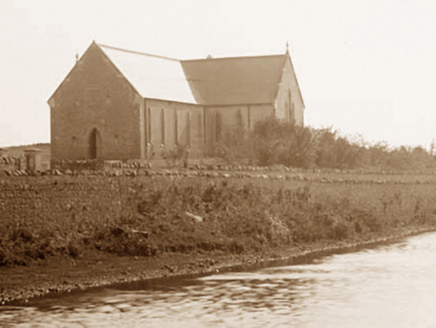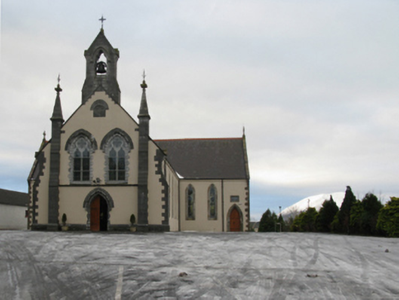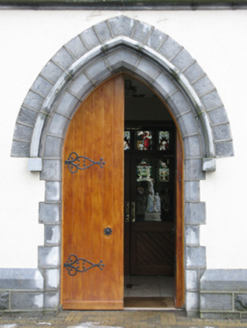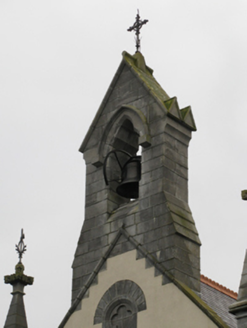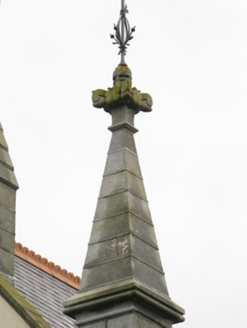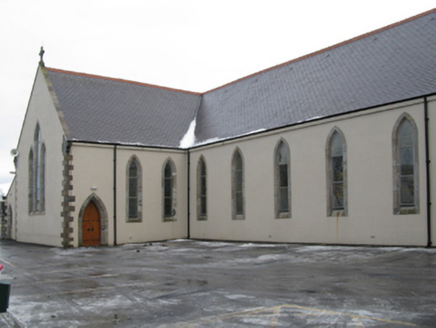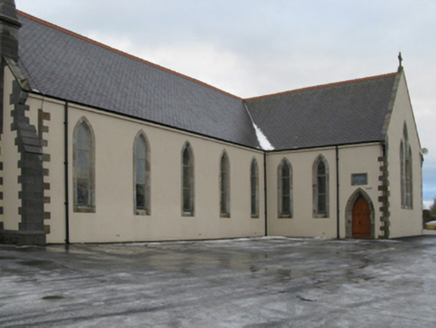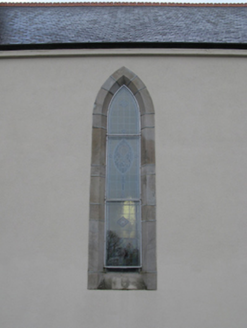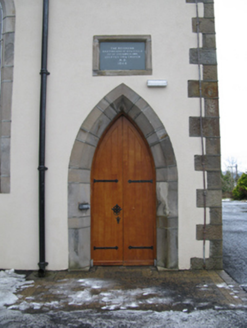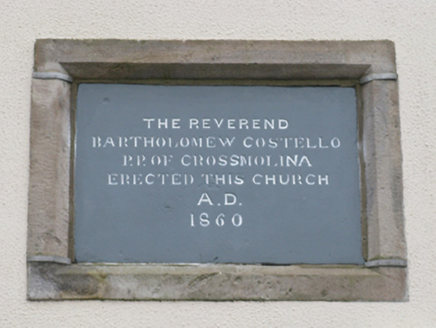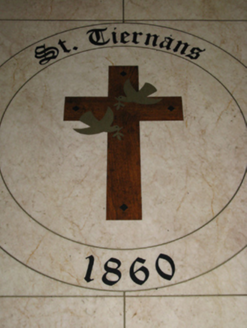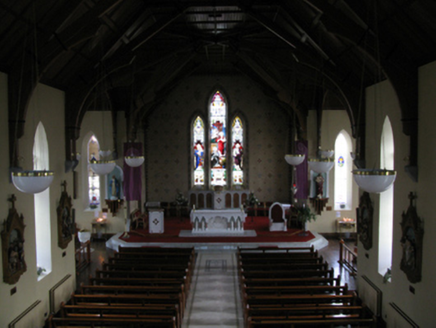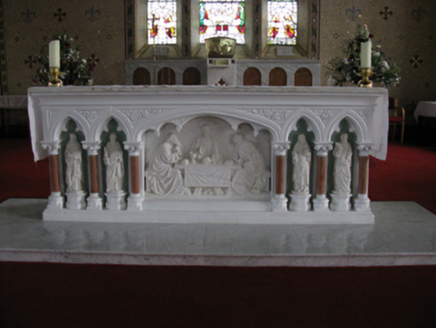Survey Data
Reg No
31205009
Rating
Regional
Categories of Special Interest
Architectural, Artistic, Historical, Scientific, Social, Technical
Original Use
Church/chapel
In Use As
Church/chapel
Date
1855 - 1865
Coordinates
113764, 317350
Date Recorded
09/12/2010
Date Updated
--/--/--
Description
Detached seven-bay double-height Catholic church, built 1859-60; dated 1860, on a cruciform plan comprising five-bay double-height nave opening into single-bay (three-bay deep) double-height transepts centred on single-bay double-height chancel to crossing (south). "Improved", 1890-2, producing present composition. Renovated, ----, with sanctuary reordered. Restored, 2007-8. Replacement pitched slate roof on a cruciform plan with trefoil-perforated crested terracotta ridge tiles, cut-limestone coping to gables on "Cavetto" kneelers with Celtic Cross finials to apexes, dragged cut-limestone coping to gable to entrance (north) front on roll moulded gabled ogee kneelers with repointed limestone ashlar buttressed gabled bellcote to apex framing embossed cast-iron bell (1907), and cast-iron rainwater goods on iron- or zinc-covered cut-limestone eaves retaining cast-iron downpipes. Replacement rendered walls with repointed drag edged tooled cut-limestone flush quoins to corners; replacement rendered surface finish to entrance (north) front on benchmark-inscribed drag edged dragged cut-limestone chamfered cushion course on repointed snecked rock faced limestone plinth with repointed crocketed obelisk pinnacle-topped drag edged tooled cut-limestone clasping stepped buttresses to corners. Lancet window openings with repointed cut-limestone surrounds having chamfered reveals framing storm glazing over fixed-pane fittings having stained glass margins centred on leaded stained glass "lozenges". Lancet "Trinity Windows" (transepts) with repointed cut-limestone surrounds having chamfered reveals framing storm glazing over fixed-pane fittings having stained glass margins centred on leaded stained glass "lozenges". Lancet "Trinity Window" (south) with repointed cut-limestone surround having chamfered reveals framing storm glazing over fixed-pane fittings having stained glass margins centred on leaded stained glass panels. Pointed-arch door opening to entrance (north) front, repointed drag edged dragged cut-limestone block-and-start surround having chamfered reveals with hood moulding on monolithic label stops framing timber boarded double doors. Paired pointed-arch window openings (gable) on cut-limestone ogee stringcourse, repointed drag edged dragged cut-limestone block-and-start surrounds having chamfered reveals with hood mouldings on monolithic label stops framing storm glazing over fixed-pane fittings having stained glass margins centred on lattice glazing bars. Pointed-arch door openings (transepts) below cut-limestone date stones ("1860") with repointed cut-limestone surrounds having chamfered reveals framing timber boarded double doors. Interior including vestibule (north); square-headed door opening into nave with glazed diagonal timber boarded double doors having overlight; full-height interior open into roof with diagonal timber boarded choir gallery (north) below pair of stained glass windows (----), central aisle with floor monument (1914) between timber pews, Gothic-style timber stations between stained glass memorial windows (----), carpeted stepped dais to sanctuary to crossing (south) reordered, ----, with Gothic-style altar (1892) below stained glass memorial "Trinity Window" (1902) in mosaic tiled surround, and exposed strutted collared timber roof construction on cut-limestone chamfered corbels with wind braced timber boarded vaulted ceiling in carved timber frame on carved timber cornice. Set in relandscaped grounds on a slightly elevated site with rendered panelled chamfered piers to perimeter having cruciform-detailed gabled capping supporting wrought iron double gates.
Appraisal
A church erected under the aegis of Reverend Bartholomew Costello PP VG (----) representing an important component of the mid nineteenth-century ecclesiastical heritage of County Mayo with the architectural value of the composition, one ascribed to an architect named only as 'Mr. Canning of Ballina' (Dublin Builder 1st August 1860, 311), confirmed by such attributes as the cruciform plan form, aligned along a liturgically-incorrect axis; the slender profile of the openings underpinning a "medieval" Gothic theme with the chancel defined by an elegant "Trinity Window"; and the handsome bellcote embellishing the roofline as a picturesque eye-catcher in the landscape: meanwhile, aspects of the composition clearly illustrate the continued development or "improvement" of the church to designs signed (1890) by William Henry Byrne (1844-1917) of Suffolk Street, Dublin (Irish Builder 24th June 1916, 288). Having been well maintained, the form and massing survive intact together with substantial quantities of the original fabric, both to the exterior and to the interior reordered (----) in accordance with the liturgical reforms sanctioned by the Second Ecumenical Council of the Vatican (1962-5) where contemporary joinery; stained glass; a much modified high altar; the O'Hara Memorial "Trinity Window" signed (1902) by Franz Mayer and Company (established 1847) of Munich and London; and gilded mosaic work, all highlight the artistic potential of the composition: meanwhile, an exposed timber roof construction pinpoints the engineering or technical dexterity of a church making a pleasing visual statement overlooking the gently meandering Deel River.
